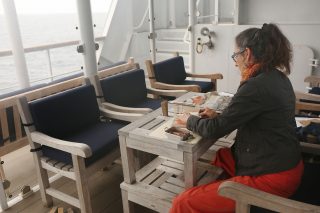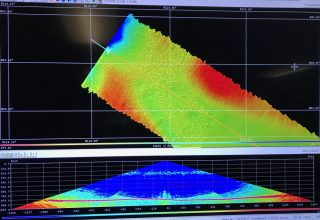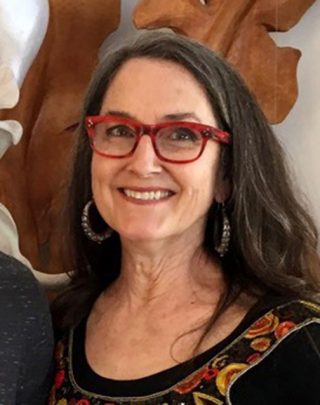My studio back at home feels very still and hopeful after a richly engaging week on Falkor. I can see I will need to settle and focus before being able to channel the big energy and ideas that were the staples of our week on board ship. It was a very dense experience of insightful exchanges between artists, absorption of unfamiliar science, and the environment rising and falling with the waves. I enjoyed the daily surprises and changing nature of the short trip, knowing it would end well before I could get deeply involved in my artwork. But, those few fertile days provided lots of material for countless productive ones ahead in my studio. At this moment the space does not look big enough to contain the artwork that will represent this oceanic experience.

Working with marine concepts and imagery, as I do regularly, I often feel the limitations of my medium when the scale of the subject is so enormous and difficult to contain. Public awareness of the marine environment is so critical to our own survival that my efforts to convey it seem puny by comparison. As an artist, it may be the only method and language I know well enough to effectively share my intense interest and concern for the oceans. My stay on the Falkor reconnected me intimately to the place where I am most creative. Now I want to produce a tangible experience that illustrates the vast scope of the ocean’s hidden topography.
Onboard R/V Falkor, I began a series of drawings in which I imagine seabed substrate starting from the beginnings of life on Earth, 4.54 billion years ago. I will continue with those as I work my way up through the strata of the seafloor and to the contemporary layering of microplastics and other manmade material that is now accumulating.

 There are other ideas that I plan to work on, arising from the stimulating sonar imagery we observed on the ship’s monitors. The swaths of rich indigo, representing the deepest water, to the bright yellow and orange of the shallows, poured across several computer screens in a rainbow gradient. These colorful and deeply contoured bands excite my rods and cones, suggesting the installation of a very long printout of the entire Cascadia Margin on a paper banner (done to scale), that allows viewers to walk the length of our mapping transect from San Diego to Astoria within a large gallery space. I look forward to doing studio experiments in the next few weeks before Schmidt Ocean Institute’s show of our artwork at San Francisco’s Exploratorium in September.
There are other ideas that I plan to work on, arising from the stimulating sonar imagery we observed on the ship’s monitors. The swaths of rich indigo, representing the deepest water, to the bright yellow and orange of the shallows, poured across several computer screens in a rainbow gradient. These colorful and deeply contoured bands excite my rods and cones, suggesting the installation of a very long printout of the entire Cascadia Margin on a paper banner (done to scale), that allows viewers to walk the length of our mapping transect from San Diego to Astoria within a large gallery space. I look forward to doing studio experiments in the next few weeks before Schmidt Ocean Institute’s show of our artwork at San Francisco’s Exploratorium in September.

